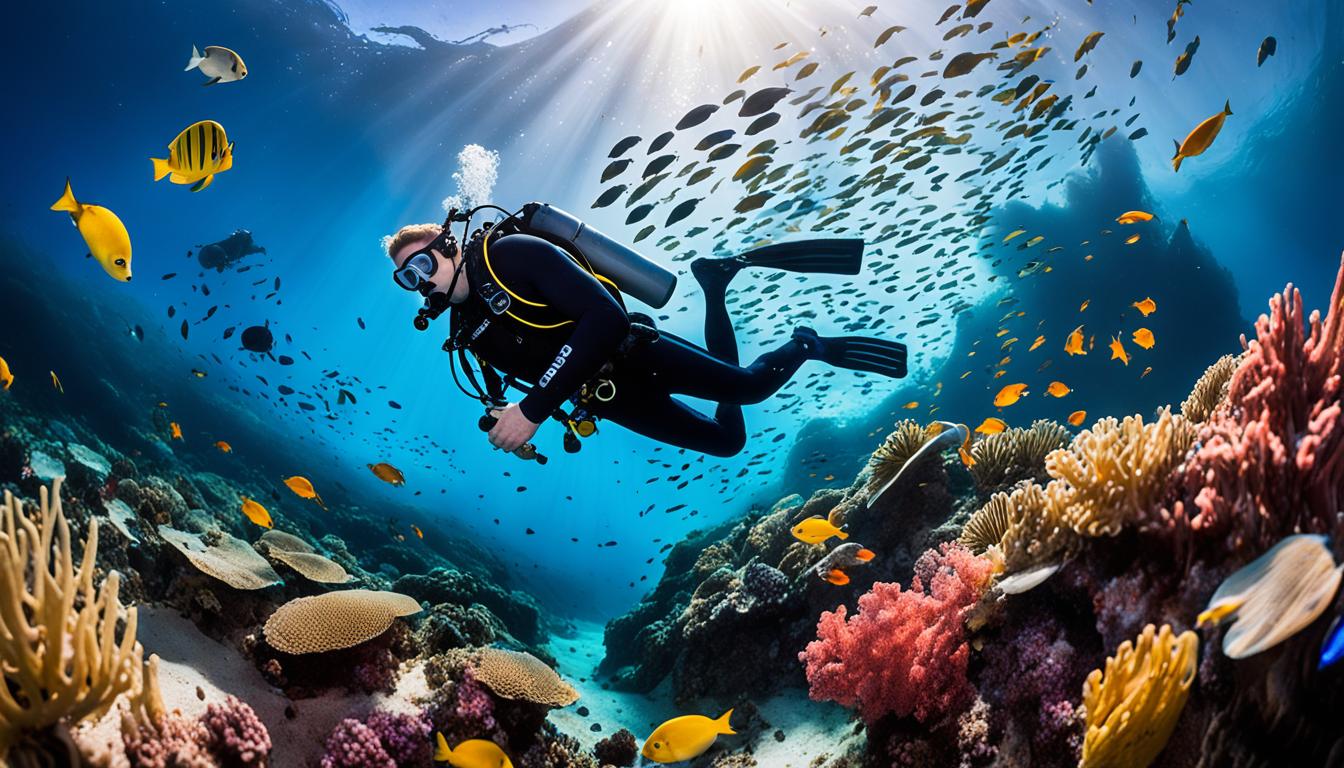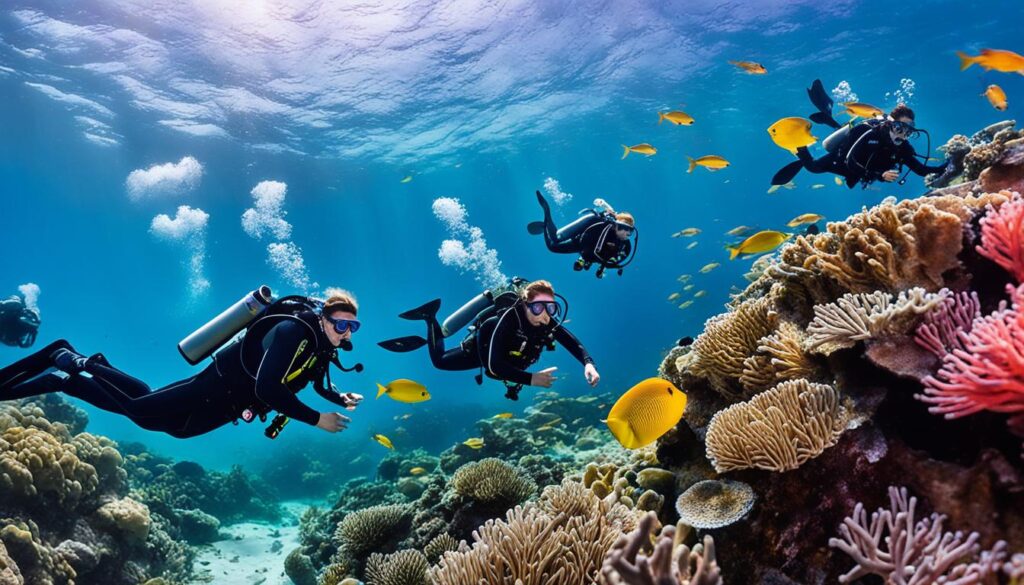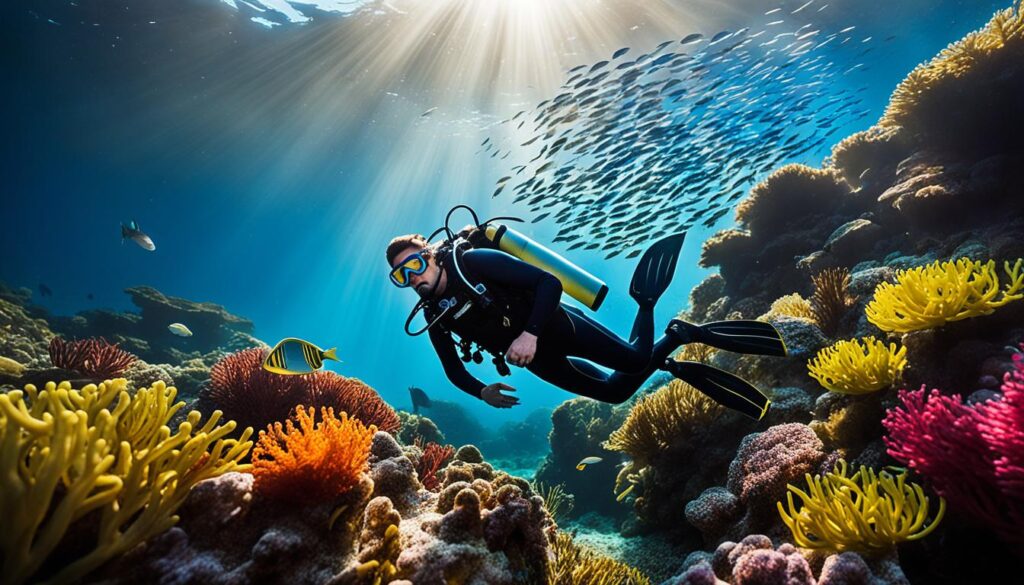
Explore Scuba Diving in New Zealand Adventures
Dive into a unique adventure with scuba diving in New Zealand. This country showcases some of the most incredible scuba diving spots New Zealand has for both locals and visitors. You’ll find everything from world-class dive sites to immersive underwater experiences New Zealand’s clear waters provide.
Get ready to meet colorful fish and explore stunning underwater scenery. Diving tours New Zealand offers guide you through these wonders. Make sure to gear up with the best diving gear New Zealand’s stores offer for a safe adventure. And if you want to learn diving, turn to diving certification New Zealand’s schools offer.
Whether you’re new to diving or experienced, diving packages New Zealand has are designed for all. Dive in and experience the breathtaking world beneath the waves in New Zealand’s oceans!
Embarking on Your Underwater Adventure: An Introduction to Scuba Diving in New Zealand
Welcome to the beautiful world of scuba diving in New Zealand. It’s a place where the ocean calls out to those who love adventure and nature. Diving here is not just a sport, it’s a full experience. It takes you into a realm governed by the rhythm of the sea and the life within it. Knowing the basics of scuba diving is key for a great and safe dive.
If you’re new or already have experience, understanding the equipment and safety is vital. Let’s dive into what you need to know. This will help make your underwater journey smooth and secure.
Scuba Diving Equipment: Your adventure starts with the right equipment. You need more than just a mask, fins, and snorkel. A dependable dive computer, a fitting wetsuit, and a proper buoyancy control device (BCD) are critical. They help ensure a safe and enjoyable dive.
Scuba Diving Tips: It’s about more than just gear. Mastering buoyancy, knowing how much air you have, and diving with a buddy are key. These tips are what make a skilled diver. Also, respecting marine life will make your scuba diving experience even better.
Scuba Diving Safety: Safety comes first, always. It’s important to know about decompression sickness and how pressure affects your body. Being ready for anything is what makes a dive trip safe and successful.
| Essential Gear | Role in Diving | Considerations |
|---|---|---|
| Dive Computer | Monitors dive time and depth | Pick one that suits your dive style and complexity. |
| Wetsuit | Thermal protection | Choose according to water temperature. |
| BCD | Buoyancy control | Must fit well and accommodate all dive gear. |
| Dive Mask | Clear vision underwater | Must have a comfortable, leak-free seal. |
| Fins | Efficient movement underwater | Ensure they’re the right fit and suitable for the type of diving you do. |
With the right scuba diving safety knowledge and gear, you’re nearly set to dive. But always be ready to learn more. Every dive teaches you something new. As you get ready to explore New Zealand’s blue waters, let your curiosity run as deep as the sea you dive into.
A Deep Dive into the Best Diving Sites in New Zealand
New Zealand’s waters offer amazing diving experiences that draw people from all corners of the globe. The country’s rich sea life and unique geological features make its diving sites top-notch. Here, you can swim with majestic sea creatures or explore ancient wrecks full of history.

Poor Knights Islands: A Diver’s Paradise
The Poor Knights Islands are a diver’s dream with clear waters and lots of sea life. This marine reserve stands out for scuba diving in New Zealand. It lets divers swim with big fish schools, meet different ray species, and see colorful corals.
Fiordland National Park: Striking Underwater Ecosystems
The Fiordland National Park is a must-visit for divers in best diving sites New Zealand has. Its deep waters offer peace with undersea cliffs, valleys, and varied marine creatures. Divers love the quiet they find among the huge underwater mountains.
The Wondrous Wrecks of the Rainbow Warrior and Mikhail Lermontov
The Rainbow Warrior and the Mikhail Lermontov wrecks take divers back in time. The Rainbow Warrior wreck honors a worldwide story. The vast Mikhail Lermontov wreck lets divers explore one of New Zealand’s biggest accessible shipwrecks.
Kaikoura: Dive with Dolphins and Whales
Kaikoura is perfect for those wanting to swim with the ocean’s friendliest creatures. Famous for Kaikoura diving, this place offers amazing dive with dolphins and whale experiences. Meeting these marine animals is magical and unforgettable.
| Location | Highlights | Marine Life | Best Time to Visit |
|---|---|---|---|
| Poor Knights Islands | Vibrant marine biodiversity, underwater arches | Tropical and temperate fish, nudibranchs, rays | Year-round |
| Fiordland National Park | Underwater cliffs, deep water ecosystems | Black coral, groupers, crayfish | November to March |
| Rainbow Warrior, Mikhail Lermontov Wrecks | Historic wreck exploration, artificial reefs | Kingfish, wrasse, anemones | December to April |
| Kaikoura | Encounters with dolphins and whales | Dusky dolphins, sperm whales, fur seals | November to May |
Scuba diving in New Zealand is unmatched. Whether you dive at the bustling Poor Knights Islands, the serene Fiordland National Park, or with giants at Kaikoura, every site has a story. Each deserves a spot on your dive list.
Scuba Diving in New Zealand: A Guide to Marine Reserves and Conservation
New Zealand’s marine reserves show its commitment to underwater conservation. These places are key in keeping the ocean’s balance. They help the many species living under the sea. For scuba diving fans in New Zealand, it’s vital to respect these areas. This helps in diving responsibly and supports sustainable diving.

The marine reserves New Zealand offers are vital for conservation. Each reserve has a special role in preserving ocean life. They let marine life thrive without human harm. Divers see nature in its purest form here. By following the rules, divers help protect these spots.
| Marine Reserve | Key Features | Diving Guidelines |
|---|---|---|
| Goat Island | Full of fish life, clear waters, kelp forests | No-take zone, no fishing, touch marine life less |
| Poor Knights Islands | Caves, lots of fish and invertebrates | No anchoring, don’t feed fish |
| Fiordland Marine Reserves | Unusual species, deep-water corals | Only guided diving, keep good buoyancy |
To dive in a way that’s good for the ocean, there are steps to follow. Don’t touch the coral or marine life. Throw away trash properly. Pick diving operators who care about underwater conservation in New Zealand.
- Choose sunscreens that won’t hurt ocean life.
- Help in local ocean clean-ups and conservation projects.
- Keep up with the latest in ocean research.
By working together, we can protect scuba diving in New Zealand for the future. Following rules in the marine reserves New Zealand has is key. We become protectors of the sea. It’s about the impact and memory we leave.
Choosing the Right Season for Scuba Diving in Aotearoa
Planning your trip around the diving season New Zealand is crucial for a memorable dive. Each island offers different experiences, highlighting the best time to dive New Zealand. Here are tips to plan your dives in the North and South Islands.
Navigating the Best Time to Dive in the North Island
The North Island diving scene is great all year thanks to its subtropical climate. The best time is between December and April, during summer. This period boasts warm waters and lots of marine life, perfect for photographers and fish enthusiasts.
South Island’s Prime Diving Conditions
On the other hand, the South Island diving scene peaks in winter, from May to September. The cold waters attract rare species. This time also sees fewer tourists, making for a peaceful dive. Still, the South Island’s beauty shines year-round, with diverse marine life and landscapes.
| Month | North Island Conditions | South Island Conditions |
|---|---|---|
| December – April | Warm water, high visibility, abundant marine life | Colder water, good visibility, lower tourist traffic |
| May – September | Cooler water, moderate visibility, fewer tourists | Optimal visibility, unique species, tranquil waters |
| October – November | Transition period, increasing water temperatures | Spring bloom, rising marine activity, various species visible |
Diving in North Island or the Southern waters, each season in New Zealand tells a unique story. Use this guide to line up your dive trips with the best visibility, marine life, and conditions. Make your dive in Aotearoa’s waters an unforgettable one.
Essential Diving Gear for New Zealand’s Waters
Getting ready for scuba diving in New Zealand needs careful planning. This is because you have to choose the right diving gear. The weather and water temperatures change a lot there, so your gear must match New Zealand’s unique diving spots. Whether you’re exploring vibrant coral at the Poor Knights Islands or the cool waters of Milford Sound, the right gear keeps you safe and comfy. Let’s look at key pieces of equipment that ensure fun and safety under the sea.
Diving Suits for New Zealand’s Varied Climates
When picking diving suits, think about the water temperatures you’ll face in New Zealand. Waters there can be warm in the north and very cold in the southern fjords. Choose a wet suit between 5 to 7mm thick or a semi-dry or dry suit for colder spots. The suit should be made of neoprene to be flexible and durable. It also needs to fit well so it keeps you warm but lets you move freely.
The Must-Have Equipment Checklist
An equipment checklist is key for diving adventures. Whether you rent diving gear in New Zealand or bring your own, every piece is important. Here’s a checklist to get your gear ready:
| Equipment | Description | Notes |
|---|---|---|
| Diving Mask and Snorkel | Clear visibility is crucial; opt for a mask with a comfortable seal and a snorkel with a purge valve. | Test for fit and comfort before your dive. |
| Fins | Choose between open-heel or full-foot depending on the type of diving and water conditions. | Consider your comfort and the ease of maneuverability. |
| BCD (Buoyancy Control Device) | Essential for buoyancy control; should fit snugly but comfortably. | Check for weight integration system compatibility. |
| Regulator with Pressure Gauge | Vital for breathing underwater; includes an octopus (backup regulator). | Ensure it is well maintained and suitable for the water temperature. |
| Dive Computer | Tracks your depth, bottom time, and ascent rate; a crucial safety device. | Bring a spare if possible and make sure it’s set for the appropriate altitude. |
| Exposure Protection | Diving suit, gloves, and boots to protect against the cold and rugged environment. | Consider the dive site’s requirements for thickness and coverage. |
| Accessories | Include items like a dive knife, torch, and surface signaling devices. | Check local regulations and dive site restrictions on certain gear. |
Scuba diving in New Zealand is an amazing adventure, both above and under the sea. With the right diving suits and gear, divers can fully enjoy and appreciate the beautiful surroundings. And most importantly, stay safe and comfortable during their dives.
Getting Certified: Diving Courses and Schools in New Zealand
Starting your learn to dive in New Zealand adventure is thrilling. It opens up a whole new world under the sea. New Zealand has lots of dive schools for people at all levels. Whether you’re just starting or you’re already experienced, there’s something for everyone.
Looking to get scuba diving certification New Zealand? You’re in luck. New Zealand has top-notch programs like PADI and SSI. These certifications mean you can dive safely all around the world.
In diving courses New Zealand, the temperate waters are a perfect classroom. Beginners can learn basic skills, while more advanced divers can take on challenges like deep diving and navigation. Whatever your level, you’ll find a course to inspire you.
| Course | Description | Duration |
|---|---|---|
| Open Water Diver | Introductory course that covers basic diving skills, safety knowledge, and equipment handling | 3-4 days |
| Advanced Open Water Diver | Expands on the skills learned in the Open Water course and includes deep diving and navigation | 2-3 days |
| Rescue Diver | Teaches problem prevention and management, focusing on the safety of both the diver and their buddies | About 3-4 days |
| Specialty Courses | Courses focusing on specific interests such as wreck diving, night diving, or underwater photography | Varies per specialty |
There are also programs for those wanting to make a career out of diving. Diving schools New Zealand offer Divemaster and instructor courses. These are for those who wish to lead dives and teach the next generation of divers.
To begin your learn to dive in New Zealand journey, contact respected dive centers. They offer both practical lessons and real diving experiences. With proper training and a spirit of adventure, you can explore New Zealand’s amazing seas.
Conclusion
We’ve discovered that New Zealand’s waters offer an amazing adventure. They’re full of colorful marine life and stunning views. Our journey showed us the incredible sights at the Poor Knights Islands. We also explored the secrets of sunken ships.
Our story about scuba diving in New Zealand concludes with a huge takeaway. There’s something for everyone, whether you’re new to diving or very experienced. New Zealand works hard to keep its waters clean and safe for everyone in the future.
So, as we end this article, let New Zealand’s seas call you to adventure. Be ready with knowledge, respect for the sea, and lots of excitement. New Zealand’s waters have many secrets for those willing to explore. Dive in and let the mix of excitement and peace surround you.
FAQ
What is scuba diving?
Scuba diving is exploring the underwater world with special gear. People use equipment like masks and fins. They breathe underwater thanks to a device called a scuba.
What equipment do I need for scuba diving in New Zealand?
You need key gear for diving in New Zealand. This includes a wetsuit, diving boots, and a mask. Don’t forget fins, a buoyancy device, and a regulator. You’ll also need a dive computer and light for safety.
What are some of the best diving sites in New Zealand?
Great diving spots in New Zealand include Poor Knights Islands and Fiordland National Park. There’s also the Rainbow Warrior wreck and the Mikhail Lermontov wreck. Kaikoura is amazing for diving with dolphins and whales.
How can I dive responsibly and contribute to marine conservation in New Zealand?
Dive carefully to help protect the ocean in New Zealand. Don’t touch marine life or take anything from the sea. It’s good to dive in marine reserves to support ecosystem protection.
When is the best time to scuba dive in New Zealand?
The best time to dive in New Zealand varies by location. The North Island is great from November to April. The South Island has good conditions from December to May. Always check the weather and marine life activity before you go.
Where can I get certified for scuba diving in New Zealand?
You can get scuba certified through PADI or SSI in New Zealand. Top diving schools include Dive HQ, New Zealand Sea Adventures, and Go Dive Marlborough.
Source Links
- https://traveltriangle.com/blog/scuba-diving-in-new-zealand/
- https://www.holidify.com/pages/scuba-diving-in-new-zealand-5452.html
- https://www.newzealand.com/uk/diving/

Leave a Reply